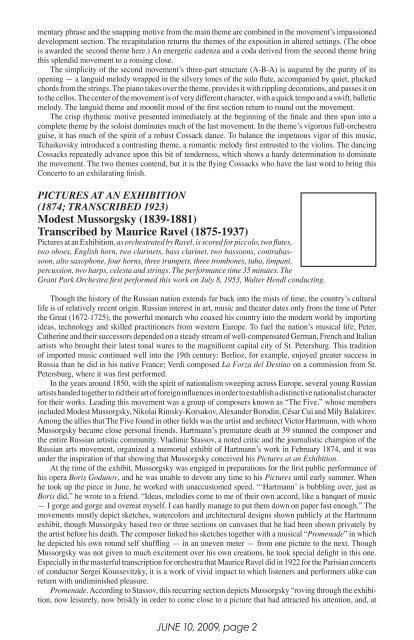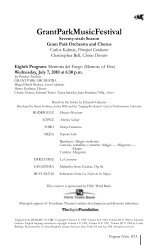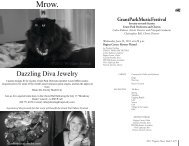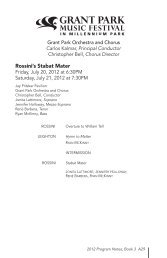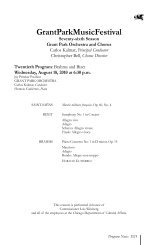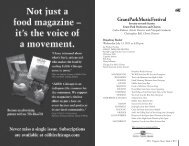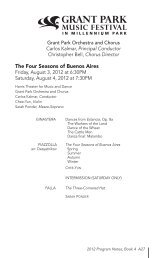Peter ilyich tchaikovsky (1840-1893) - The Grant Park Music Festival
Peter ilyich tchaikovsky (1840-1893) - The Grant Park Music Festival
Peter ilyich tchaikovsky (1840-1893) - The Grant Park Music Festival
You also want an ePaper? Increase the reach of your titles
YUMPU automatically turns print PDFs into web optimized ePapers that Google loves.
mentary phrase and the snapping motive from the main theme are combined in the movement’s impassioned<br />
development section. <strong>The</strong> recapitulation returns the themes of the exposition in altered settings. (<strong>The</strong> oboe<br />
is awarded the second theme here.) An energetic cadenza and a coda derived from the second theme bring<br />
this splendid movement to a rousing close.<br />
<strong>The</strong> simplicity of the second movement’s three-part structure (A-B-A) is augured by the purity of its<br />
opening — a languid melody wrapped in the silvery tones of the solo flute, accompanied by quiet, plucked<br />
chords from the strings. <strong>The</strong> piano takes over the theme, provides it with rippling decorations, and passes it on<br />
to the cellos. <strong>The</strong> center of the movement is of very different character, with a quick tempo and a swift, balletic<br />
melody. <strong>The</strong> languid theme and moonlit mood of the first section return to round out the movement.<br />
<strong>The</strong> crisp rhythmic motive presented immediately at the beginning of the finale and then spun into a<br />
complete theme by the soloist dominates much of the last movement. In the theme’s vigorous full-orchestra<br />
guise, it has much of the spirit of a robust Cossack dance. To balance the impetuous vigor of this music,<br />
Tchaikovsky introduced a contrasting theme, a romantic melody first entrusted to the violins. <strong>The</strong> dancing<br />
Cossacks repeatedly advance upon this bit of tenderness, which shows a hardy determination to dominate<br />
the movement. <strong>The</strong> two themes contend, but it is the flying Cossacks who have the last word to bring this<br />
Concerto to an exhilarating finish.<br />
Pictures at an Exhibition<br />
(1874; transcribed 1923)<br />
Modest Mussorgsky (1839-1881)<br />
Transcribed by Maurice Ravel (1875-1937)<br />
Pictures at an Exhibition, as orchestrated by Ravel, is scored for piccolo, two flutes,<br />
two oboes, English horn, two clarinets, bass clarinet, two bassoons, contrabassoon,<br />
alto saxophone, four horns, three trumpets, three trombones, tuba, timpani,<br />
percussion, two harps, celesta and strings. <strong>The</strong> performance time 35 minutes. <strong>The</strong><br />
<strong>Grant</strong> <strong>Park</strong> Orchestra first performed this work on July 8, 1953, Walter Hendl conducting.<br />
Though the history of the Russian nation extends far back into the mists of time, the country’s cultural<br />
life is of relatively recent origin. Russian interest in art, music and theater dates only from the time of <strong>Peter</strong><br />
the Great (1672-1725), the powerful monarch who coaxed his country into the modern world by importing<br />
ideas, technology and skilled practitioners from western Europe. To fuel the nation’s musical life, <strong>Peter</strong>,<br />
Catherine and their successors depended on a steady stream of well-compensated German, French and Italian<br />
artists who brought their latest tonal wares to the magnificent capital city of St. <strong>Peter</strong>sburg. This tradition<br />
of imported music continued well into the 19th century: Berlioz, for example, enjoyed greater success in<br />
Russia than he did in his native France; Verdi composed La Forza del Destino on a commission from St.<br />
<strong>Peter</strong>sburg, where it was first performed.<br />
In the years around 1850, with the spirit of nationalism sweeping across Europe, several young Russian<br />
artists banded together to rid their art of foreign influences in order to establish a distinctive nationalist character<br />
for their works. Leading this movement was a group of composers known as “<strong>The</strong> Five,” whose members<br />
included Modest Mussorgsky, Nikolai Rimsky-Korsakov, Alexander Borodin, César Cui and Mily Balakirev.<br />
Among the allies that <strong>The</strong> Five found in other fields was the artist and architect Victor Hartmann, with whom<br />
Mussorgsky became close personal friends. Hartmann’s premature death at 39 stunned the composer and<br />
the entire Russian artistic community. Vladimir Stassov, a noted critic and the journalistic champion of the<br />
Russian arts movement, organized a memorial exhibit of Hartmann’s work in February 1874, and it was<br />
under the inspiration of that showing that Mussorgsky conceived his Pictures at an Exhibition.<br />
At the time of the exhibit, Mussorgsky was engaged in preparations for the first public performance of<br />
his opera Boris Godunov, and he was unable to devote any time to his Pictures until early summer. When<br />
he took up the piece in June, he worked with unaccustomed speed. “‘Hartmann’ is bubbling over, just as<br />
Boris did,” he wrote to a friend. “Ideas, melodies come to me of their own accord, like a banquet of music<br />
— I gorge and gorge and overeat myself. I can hardly manage to put them down on paper fast enough.” <strong>The</strong><br />
movements mostly depict sketches, watercolors and architectural designs shown publicly at the Hartmann<br />
exhibit, though Mussorgsky based two or three sections on canvases that he had been shown privately by<br />
the artist before his death. <strong>The</strong> composer linked his sketches together with a musical “Promenade” in which<br />
he depicted his own rotund self shuffling — in an uneven meter — from one picture to the next. Though<br />
Mussorgsky was not given to much excitement over his own creations, he took special delight in this one.<br />
Especially in the masterful transcription for orchestra that Maurice Ravel did in 1922 for the Parisian concerts<br />
of conductor Sergei Koussevitzky, it is a work of vivid impact to which listeners and performers alike can<br />
return with undiminished pleasure.<br />
Promenade. According to Stassov, this recurring section depicts Mussorgsky “roving through the exhibition,<br />
now leisurely, now briskly in order to come close to a picture that had attracted his attention, and, at<br />
JUNE 10, 2009, page


